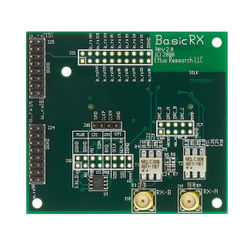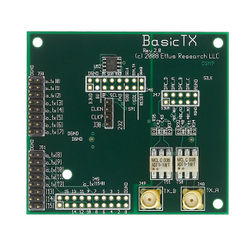Difference between revisions of "BasicTX/BasicRX"
(→BasicTX=) |
m (→Device Overview: small wording tweaks for correctness) |
||
| (29 intermediate revisions by 3 users not shown) | |||
| Line 1: | Line 1: | ||
== Device Overview == | == Device Overview == | ||
| − | The | + | |
| + | The BasicRX/BasicTX daughterboards are low-cost daughterboards that provides direct access to the ADC inputs. The boards accept real-mode only signals from 1 to 250 MHz. The BasicRX/BasicTX is ideal for applications using an external front end providing relatively clean signals within operable bandwidth. Wideband transformers couple each RF input to a single channel of the USRP device's ADC. The signals sampled by the ADC are manipulated in the FPGA, and the outputs can be processed independently, or as a single I/Q pair. The BasicTX/BasicRX daughterboards are supported by the USRP Hardware Driver™ (UHD) software API for seamless integration into existing applications. | ||
== Key Features== | == Key Features== | ||
| Line 11: | Line 12: | ||
|} | |} | ||
| − | == | + | ==Daughterboard Specifications== |
| − | + | ===Frontends=== | |
| + | ''' BasicRX''' | ||
| + | |||
| + | The BasicRX has 4 frontends: | ||
| + | |||
| + | * '''Frontend A''': real signal on antenna RXA | ||
| + | * '''Frontend B''': real signal on antenna RXB | ||
| + | * '''Frontend AB''': quadrature frontend using both antennas (IQ) | ||
| + | * '''Frontend BA''': quadrature frontend using both antennas (QI) | ||
| + | |||
| + | '''BasicTX''' | ||
| + | |||
| + | The BasicTX has 4 frontends: | ||
| + | |||
| + | * '''Frontend A''': real signal on antenna TXA | ||
| + | * '''Frontend B''': real signal on antenna TXB | ||
| + | * '''Frontend AB''': quadrature frontend using both antennas (IQ) | ||
| + | * '''Frontend BA''': quadrature frontend using both antennas (QI) | ||
| + | |||
| + | ===Gains=== | ||
| + | '''BasicRX''' | ||
| + | * The BasicRX has no tunable elements or programmable gains. Through the magic of aliasing, you can down-convert signals greater than the Nyquist rate of the ADC. | ||
| + | |||
| + | '''BasicTX''' | ||
| + | * The BasicTX has no tunable elements or programmable gains. Through the magic of aliasing, you can up-convert signals greater than the Nyquist rate of the DAC. | ||
| + | |||
| + | ===Bandwidths=== | ||
| + | '''BasicRX''' | ||
| + | * '''For Real-Mode (A or B frontend)''': 250 MHz | ||
| + | * '''For Complex (AB or BA frontend)''': 500 MHz | ||
| + | |||
| + | '''BasicTX''' | ||
| + | * '''For Real-Mode (A or B frontend)''': 250 MHz | ||
| + | * '''For Complex (AB or BA frontend)''': 500 MHz | ||
| + | |||
| + | ===Input/Output Impedance=== | ||
| + | * All RF Ports are matched to 50 Ohm with -10dB or better return loss generally. Detailed test is pending. | ||
| + | |||
| + | ===Input Power Levels=== | ||
| + | * The maximum input power for the BasicRX is +10 dBm. | ||
==Hardware Specifications== | ==Hardware Specifications== | ||
| + | * Ettus Research recommends to always use the latest stable version of UHD | ||
| + | |||
===BasicRX=== | ===BasicRX=== | ||
| − | * | + | * Current Hardware Revision: 1 |
| + | * Minimum version of UHD required: 3.8.0 | ||
===BasicTX=== | ===BasicTX=== | ||
| − | * | + | * Current Hardware Revision: 1 |
| − | + | * Minimum version of UHD required: 3.8.0 | |
| − | + | ||
| − | + | ||
==Environmental Specifications== | ==Environmental Specifications== | ||
| − | + | ===Operating Temperature Range=== | |
| + | * 0-40 °C | ||
| + | |||
| + | ===Operating Humidity Range=== | ||
| + | * 10% to 90% non-condensing | ||
==USRP Compatibility== | ==USRP Compatibility== | ||
| Line 41: | Line 86: | ||
[http://files.ettus.com/schematics/basic_dbs/BasicTX.pdf Basic TX Schematics] | [http://files.ettus.com/schematics/basic_dbs/BasicTX.pdf Basic TX Schematics] | ||
| − | ==Datasheets== | + | ==Key Component Datasheets== |
| − | + | {| class="wikitable" style="width:80%" | |
| + | !Part Number | ||
| + | !Description | ||
| + | !Schematic ID (Page) | ||
| + | |- | ||
| − | ==Mechanical | + | |[http://ww1.microchip.com/downloads/en/DeviceDoc/21210N.pdf 24LC025B] |
| − | + | |EEPROM | |
| + | |U1 (1); U52 (1) | ||
| + | |- | ||
| + | |||
| + | |[https://www.minicircuits.com/pdfs/ADT1-1WT.pdf ADT1−1WT] | ||
| + | |RF Transformer | ||
| + | |T1 (1); T2 (1); T50 (1); T51 (1) | ||
| + | |||
| + | |} | ||
| + | |||
| + | ==Mechanical Information== | ||
| + | ===Drawings=== | ||
| + | * BasicRX - [[File:cu ettus-cca-basic-rx.pdf]] | ||
==RF Connectors== | ==RF Connectors== | ||
| Line 54: | Line 115: | ||
As of December 1st, 2010 all Ettus Research products are RoHS compliant unless otherwise noted. More information can be found at [http://ettus.com/legal/rohs-information http://ettus.com/legal/rohs-information] | As of December 1st, 2010 all Ettus Research products are RoHS compliant unless otherwise noted. More information can be found at [http://ettus.com/legal/rohs-information http://ettus.com/legal/rohs-information] | ||
| + | ===China RoHS=== | ||
| + | '''Management Methods for Controlling Pollution Caused by Electronic Information Products Regulation''' | ||
| − | + | '''Chinese Customers''' | |
| − | + | ||
| − | + | National Instruments is in compliance with the Chinese policy on the Restriction of Hazardous Substances (RoHS) used in Electronic Information Products. For more information about the National Instruments China RoHS compliance, visit [http://www.ni.com/environment/rohs_china ni.com/environment/rohs_china]. | |
| − | + | ||
| + | ==Certificate of Volatility== | ||
| + | [https://www.ni.com/pdf/manuals/377303a.pdf BasicRX / BasicTX Letter of Volatility] | ||
==Downloads== | ==Downloads== | ||
Latest revision as of 10:50, 29 September 2020
Contents
Device Overview
The BasicRX/BasicTX daughterboards are low-cost daughterboards that provides direct access to the ADC inputs. The boards accept real-mode only signals from 1 to 250 MHz. The BasicRX/BasicTX is ideal for applications using an external front end providing relatively clean signals within operable bandwidth. Wideband transformers couple each RF input to a single channel of the USRP device's ADC. The signals sampled by the ADC are manipulated in the FPGA, and the outputs can be processed independently, or as a single I/Q pair. The BasicTX/BasicRX daughterboards are supported by the USRP Hardware Driver™ (UHD) software API for seamless integration into existing applications.
Key Features
|
Daughterboard Specifications
Frontends
BasicRX
The BasicRX has 4 frontends:
- Frontend A: real signal on antenna RXA
- Frontend B: real signal on antenna RXB
- Frontend AB: quadrature frontend using both antennas (IQ)
- Frontend BA: quadrature frontend using both antennas (QI)
BasicTX
The BasicTX has 4 frontends:
- Frontend A: real signal on antenna TXA
- Frontend B: real signal on antenna TXB
- Frontend AB: quadrature frontend using both antennas (IQ)
- Frontend BA: quadrature frontend using both antennas (QI)
Gains
BasicRX
- The BasicRX has no tunable elements or programmable gains. Through the magic of aliasing, you can down-convert signals greater than the Nyquist rate of the ADC.
BasicTX
- The BasicTX has no tunable elements or programmable gains. Through the magic of aliasing, you can up-convert signals greater than the Nyquist rate of the DAC.
Bandwidths
BasicRX
- For Real-Mode (A or B frontend): 250 MHz
- For Complex (AB or BA frontend): 500 MHz
BasicTX
- For Real-Mode (A or B frontend): 250 MHz
- For Complex (AB or BA frontend): 500 MHz
Input/Output Impedance
- All RF Ports are matched to 50 Ohm with -10dB or better return loss generally. Detailed test is pending.
Input Power Levels
- The maximum input power for the BasicRX is +10 dBm.
Hardware Specifications
- Ettus Research recommends to always use the latest stable version of UHD
BasicRX
- Current Hardware Revision: 1
- Minimum version of UHD required: 3.8.0
BasicTX
- Current Hardware Revision: 1
- Minimum version of UHD required: 3.8.0
Environmental Specifications
Operating Temperature Range
- 0-40 °C
Operating Humidity Range
- 10% to 90% non-condensing
USRP Compatibility
BasicRX
- N or X Series
BasicTX
- N or X Series
Schematics
Basic RX
Basic TX
Key Component Datasheets
| Part Number | Description | Schematic ID (Page) |
|---|---|---|
| 24LC025B | EEPROM | U1 (1); U52 (1) |
| ADT1−1WT | RF Transformer | T1 (1); T2 (1); T50 (1); T51 (1) |
Mechanical Information
Drawings
- BasicRX - File:cu ettus-cca-basic-rx.pdf
RF Connectors
- The BasicTX/RX daughterboard features female SMA connectors for both the RX and TX connectors.
Certifications
RoHS
As of December 1st, 2010 all Ettus Research products are RoHS compliant unless otherwise noted. More information can be found at http://ettus.com/legal/rohs-information
China RoHS
Management Methods for Controlling Pollution Caused by Electronic Information Products Regulation
Chinese Customers
National Instruments is in compliance with the Chinese policy on the Restriction of Hazardous Substances (RoHS) used in Electronic Information Products. For more information about the National Instruments China RoHS compliance, visit ni.com/environment/rohs_china.
Certificate of Volatility
BasicRX / BasicTX Letter of Volatility


